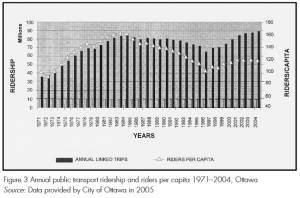Thinking Outside the Bus
University of California Transportation Centre
“All else equal, the purpose of transit is to convey users to destinations, not simply to make them equally happy at stops and stations. Thus our findings suggest that transit managers, when they have a choice, would be well-advised to favor service frequency/reliability improvements over stop or station improvements. While lower in-vehicle travel times and comfortable, informative, and attractive stops and stations can make traveling by public transit more agreeable, what surveyed passengers report that they really want most is safe, frequent, and reliable service, plain and simple.”
http://www.uctc.net/access/40/access40_outsidethebus.shtml
Top Eight Reasons People Give up on Public Transit
“Riders don’t mind standing in crowded buses or trains as long as the vehicles move without delay and run frequently.”
“Small vehicles running more often may be better than large vehicles running less often.”
http://www.forbes.com/sites/jeffmcmahon/2013/03/06/top-eight-reasons-people-give-up-on-public-transit/
Rapid Transit Funding Announcement – Nov. 19, 2013
The city and the province announced that they would both be contributing $225 million to the Southwest Corridor on November 19, 2013
http://news.gov.mb.ca/news/index.html?item=19593
Transportation Cost and Benefit Analysis II — Travel Time Costs
Victoria Transportation Policy Institute
A discussion of how individuals choose to use various transportation options
“if a highway or transit improvement increases travel speeds, commuters often accept longer distance commutes.” (pg 5.2-6)
“Conventional transport evaluation often undervalues qualitative travel time cost factors, which skews planning decisions to favor increased travel speed at the expense of other improvements. For example, conventional evaluation accounts for roadway widening travel time savings but not the additional delay it causes for walking and cycling (called the Barrier Effect). Similarly, reduced unit cost from improved walking conditions and more comfortable transit vehicles are seldom quantified and so are undervalued compared with projects that increase vehicle travel speeds.” (pg 5.2-6)
http://www.vtpi.org/tca/tca0502.pdf
Hate to Wait: Effects of Wait Time on Public Transit Travelers’ Perceptions
National Centre for Smart Growth Research and Education
http://smartgrowth.umd.edu/hatetowaiteffectsofwaittimeonpublictransittraveler.html.

